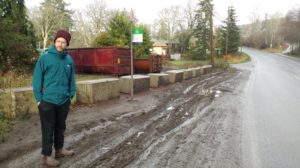A Camosun College student is concerned about the state of the bike lane on Interurban road near Camosun College’s Interurban campus.
Third-year electronics student Philip Marciniak has been cycling to the Interurban campus for three years; he says that in November he came “within a foot or so, maybe a bit less” with a car after dodging a large mud puddle in the bike lane.
“It’s a bylaw issue, which somehow means that it just doesn’t get dealt with ever,” says Marciniak. “I don’t understand. The end result is just a really dangerous situation.”

Marciniak says that the college could apply more pressure on Saanich.
“[Saanich] loves to say, ‘Oh, we’ve got these active transportation plans,’ [but] you look at the state of the bike lane that leads to the school and it’s a total mess,” he says.
District of Saanich spokesperson Megan Catalano says the district is aware of the debris that is being deposited on the roadway; when asked if Saanich knew who it was being deposited by, Catalano says, “I can’t really elaborate further than that; no. We don’t have a definitive answer on that.”
“Our bylaw enforcement section is aware of the complaint, and the district is assessing whether there are any additional options available to address the road debris at that location,” says Catalano.
Catalano says that Saanich has increased the frequency of street sweeping in the area in the meantime.
“We do only have one street sweeper, so we’ve increased kind of to the maximum allowable [frequency] while keeping up sufficient service levels in other areas of Saanich,” she says, adding that she cannot comment any further.
Camosun manager of campus sustainability Maria Bremner says that the college has written two formal letters to Saanich, as well as written numerous emails and made phone calls to the municipality. Bremner says that a company, which she did not name, based on Alan Road, is “somewhat responsible” for the situation.
MacNutt Enterprises is a topsoil provider based on Alan Road; they did not respond to requests for an interview.
Bremner confirmed that a Camosun student recently broke a bone after being struck by a vehicle about a kilometre from the patch of road Marciniak is concerned about.
“I think these are things that are important for anyone on that corridor to know about; these are issues,” says Marciniak.
A lot of times when people ride and see similar problems, says Marciniak, they don’t bring it up because “you think it’s just something that you’re experiencing.”
“To know that there’s other people that are getting injured, that are getting hit by cars, that are also experiencing these unsafe conditions—other Camosun students—I think it’s important for the community to know,” says Marciniak. “I think it’s important for students to know, for the college to know.”
Bremner says the college would like to see bike-lane issues on this corridor get fixed so that students can feel safe using active transportation.
“It’s been an ongoing problem for quite some time,” says Bremner, who says it’s been an issue since she started at the college in 2012.
Bremner, who is also a cyclist and has experience riding the stretch Marciniak is concerned with, says the big issue is debris, but also the topography of the landscape.
“We need a longer-term infrastructure fix on this,” she says, adding that she requests regular street sweeping from Saanich. “It’s a bylaw issue. We definitely would like to see some work done on that. We would like, in an ideal world, that that lane should be safe for cyclists. The college would like to see, obviously, arteries coming to and from both of our campuses to be safe and to encourage people to want to get on their bikes.”
Marciniak—who says it is hard to believe Saanich can let this happen given the strong advocacy they take on active transportation—points to bylaw 8.07 out of the District of Saanich’s Streets and Traffic Regulation Bylaw, which states “no person: (a) Shall cause, suffer or permit loose material to be deposited or accumulate or remain upon any sidewalk, street or public place.”
Both Marciniak and Bremner say that part of the problem is also the volume of vehicles on the road, especially during rush hour.
“Traffic’s backed up there, but you got cars backed up on the left side. You can’t go into the lane; if it’s really bad or if there’s rocks or gravel, you basically have to almost come to a stop,” says Marciniak.
BC Transit recently put a new bus stop near the area of concern, right next to the bike lane that Marciniak says is “like a mud pit.”
Bremner says that she will be prioritizing this issue.
“Given that the progress on this particular area has been so slow, it’s definitely something that I would like to prioritize from my end to put further pressure on Saanich to address in a timely way,” she says.
Marciniak says that he will continue to use the Interurban corridor, but he wants to see the problems get fixed.
“Somehow nobody can step up and see that it’s an issue and get it dealt with,” he says.
Marciniak says it feels like there’s no short-term solution but the college could put more pressure on Saanich.
“Maybe if they raised this issue a little bit more,” he says. “The college loves to say, ‘We’re all about sustainability, we’re all about renewable energy.’”
Bremner says there is a “whole laundry list” of priorities in the Saanich municipality around active transport. She says the college would like to get this issue “bumped up in the queue.”
“They’ve responded to the letters, but I think a true response would be doing something about it,” says Bremner.

